New York: A team of researchers has devised a test that could measure patient immunity against multiple Covid-19 variants such as Omicron and Delta at once and inform which synthetic monoclonal antibody to use for treatments.
The findings showed that this test could potentially tell doctors how protected a patient is from new variants and those currently circulating in a community or, conversely, which monoclonal antibodies to treat a Covid-19 patient.
“While developing a point-of-care test for Covid-19 antibodies and biomarkers, we realised there could be some benefit to being able to detect the ability of antibodies to neutralise specific variants, so we built a test around that idea,” said researcher Ashutosh Chilkoti from the Duke University.
The test’s technology hinges on a polymer brush coating that acts as a sort of non-stick coating to stop anything but the desired biomarkers from attaching to the test slide when wet.
The high effectiveness of this non-stick shield makes the test incredibly sensitive to even low levels of its targets. The approach allows researchers to print different molecular traps on different areas of the slide to catch multiple biomarkers at once.
In this application, researchers print fluorescent human ACE2 proteins — the cellular targets of the virus’s infamous spike protein — on a slide.
They also print spike proteins specific to each variant of Covid-19 at different specific locations. When the test is run, the ACE2 proteins detach from the slide and are caught by the spike proteins still attached to the slide, causing the slide to glow.
But in the presence of neutralising antibodies, the spike proteins are no longer able to grab onto the ACE2 proteins, making the slide glow less, indicating the effectiveness of the antibodies.
By printing different variants of the Covid-19 spike protein on different portions of the slide, researchers can see how effective the antibodies are at preventing each variant from latching onto their human cellular target simultaneously.
In the paper, published in the journal Science Advances, the team tested the technology in several different ways.

